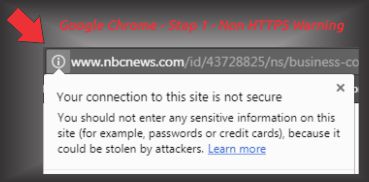[vc_row][vc_column][heading animation_iteration=”1″ align=”aligncenter”]Google Chrome’s HTTPS Campaign Underway[/heading][/vc_column][/vc_row][vc_row][vc_column][vc_column_text]

By Susan Stern, Stern PR Omaha
Updated Fri September 29, 2017
Originally Published October 2016
Google Chrome,’s ‘HTTPS Everywhere’ campaign making the web safer – is in full swing. At the end of January 2017, Chrome began labeling all websites that failed to jump on the SSL encryption bandwagon with an upside down explanation point. When pressed, users discover a warning of an insecure connection – giving the impression the site may be compromised. All websites, from mom and pop blogs to big news sites are expected to do it.
 As of September 29th, the NBC site, has not added SSL encryption nor have CNN, Foxnews, and ABC News.
As of September 29th, the NBC site, has not added SSL encryption nor have CNN, Foxnews, and ABC News.
The Washington Post, New York Times and CBS News’ websites have done the work, and have HTTPS encryption.
Next step in the staged roll out, date unknown, will be Chrome adding a red warning sign icon in red, with text that reads “Not secure.”
[/vc_column_text][heading animation_iteration=”1″ type=”2″ bottom_margin=”nomarb” align=”aligncenter”]Eventual HTTP Site Alert[/heading][heading animation_iteration=”1″ type=”2″ bottom_margin=”nomarb” align=”aligncenter”]Chrome Roll Out Gradual[/heading][vc_column_text]Google defines HTTPS (Hypertext Transfer Protocol Secure) as an “internet communication protocol that protects the integrity and confidentiality of your users’ data between the user’s computer and the site.
For example, when a user enters data into a form on your site in order to subscribe to updates or purchase a product, HTTPS protects that user’s personal information between the user and the site. Users expect a secure online experience when providing data via a website. We encourage you to adopt HTTPS in order to protect your users’ connection to your website,” said Google on its Webmaster Support Help Forum.
[/vc_column_text][image][/image][/vc_column][/vc_row][vc_row][vc_column width=”1/2″][image animation_iteration=”1″ size=”half” align=”aligncenter” alt=”google-chrome-marks-website-without-https-unsafe”]8258[/image][/vc_column][vc_column width=”1/2″][image animation_iteration=”1″ size=”half” align=”aligncenter” alt=”google-chrome-marks-website-without-https-unsafe”]8259[/image][/vc_column][/vc_row][vc_row][vc_column][heading animation_iteration=”1″ type=”2″ align=”aligncenter”]What is HTTPS? How It Works?[/heading][/vc_column][/vc_row][vc_row][vc_column][vc_column_text]Google defines HTTPS (Hypertext Transfer Protocol Secure) as an “internet communication protocol that protects the integrity and confidentiality of your users’ data between the user’s computer and the site.
For example, when a user enters data into a form on your site in order to subscribe to updates or purchase a product, HTTPS protects that user’s personal information between the user and the site. Users expect a secure online experience when providing data via a website. We encourage you to adopt HTTPS in order to protect your users’ connection to your website,” said Google on its Webmaster Support Help Forum.
[/vc_column_text][heading animation_iteration=”1″ type=”2″ bottom_margin=”lessmar2″ align=”aligncenter”]Anything You Type Goes Through Secure TLS[/heading][vc_message icon_fontawesome=”fa fa-question”]Data sent using HTTPS is secured via Transport Layer Security protocol (TLS), which provides three key layers of protection:
[/vc_message][icons_list_2 animation=”fadeInRight” animation_iteration=”1″ icon1=”fa-lock” active1=”yes” icon2=”fa-lock” active2=”yes” icon3=”fa-lock” active3=”yes” title1=”Encryption” content1=”Encrypting the exchanged data to keep it secure from eavesdroppers. That means that while the user is browsing a website, nobody can “listen“ to their conversations, track their activities across multiple pages, or steal their information.” title2=”Data Integrity” content2=”Data cannot be modified or corrupted during transfer, intentionally or otherwise, without being detected.” title3=”Authentication” content3=”Proves that your users communicate with the intended website. It protects against man-in-the-middle attacks and builds user trust, which translates into other business benefits.”][/vc_column][/vc_row][vc_message message_box_color=”black” icon_fontawesome=”fa fa-flag”]Google hints HTTPS-secured sites may receive a bigger ranking boost in the future.[/vc_message][heading animation_iteration=”1″ type=”2″ align=”aligncenter”]Google Gives Secure Sites Ranking Boost[/heading][vc_row][vc_column][vc_column_text]The good news is that Google says websites that add HTTPS encryption will receive a small search engine optimization ranking benefit. In its official Google Master Webmaster Central blog, Google describes as a “very lightweight signal” the ranking your website will increase when you beef up security:
“….affecting fewer than 1% of global queries, and carrying less weight than other signals such as high-quality content — while we give webmasters time to switch to HTTPS. But over time, we may decide to strengthen it, because we’d like to encourage all website owners to switch from HTTP to HTTPS to keep everyone safe on the web.”[vc_row][vc_column width=”1/1”][vc_column_text]
[/vc_column_text][/vc_column][/vc_row][vc_row][vc_column][heading animation_iteration=”1″ type=”2″ align=”aligncenter”]Google Wants HTTPS Everywhere on the Web[/heading][/vc_column][/vc_row][vc_row][vc_column][vc_column_text css_animation=”left-to-right”]Google’s Chrome 2016 announcement gives website marketers and developers time, before the New Year 2017, to migrate websites over to the more secure HTTPS system. Google is not alone in pushing websites to make the switch. In June 2015, the White House issued a directive mandating all federal websites use secure HTTPS connections.
Stern PR Marketing meantime scheduled the long Thanksgiving holiday 2016 to move this particular website to HTTPS. The process could take 24-72 hours for migration, followed by time to update all of the website’s image URLs (Velvet Blue WP plugin), and testing for bugs.[/vc_column_text][/vc_column][/vc_row][vc_row][vc_column][/vc_column][call_to_action animation=”slideInLeft” animation_iteration=”1″ style=”2″ icon=”fa-phone” title=”Switch from HTTP to HTTPS Now!” subtitle=”Contact Stern PR In Omaha” button_text=”Call Us” url=”https://sternprmarketing.com/contact-omaha-marketing-firm”][vc_row][vc_column][call_to_action_3 animation=”slideInRight” animation_iteration=”1″ title=”September 29, 2017 Alert” subtitle=”No Time to Procrastinate. Get Your Website SSL Encrypted Today!” button_text=”Get ‘Ur Done!” url=”https://sternprmarketing.com/contact-omaha-marketing-firm”][/vc_column][/vc_row]